
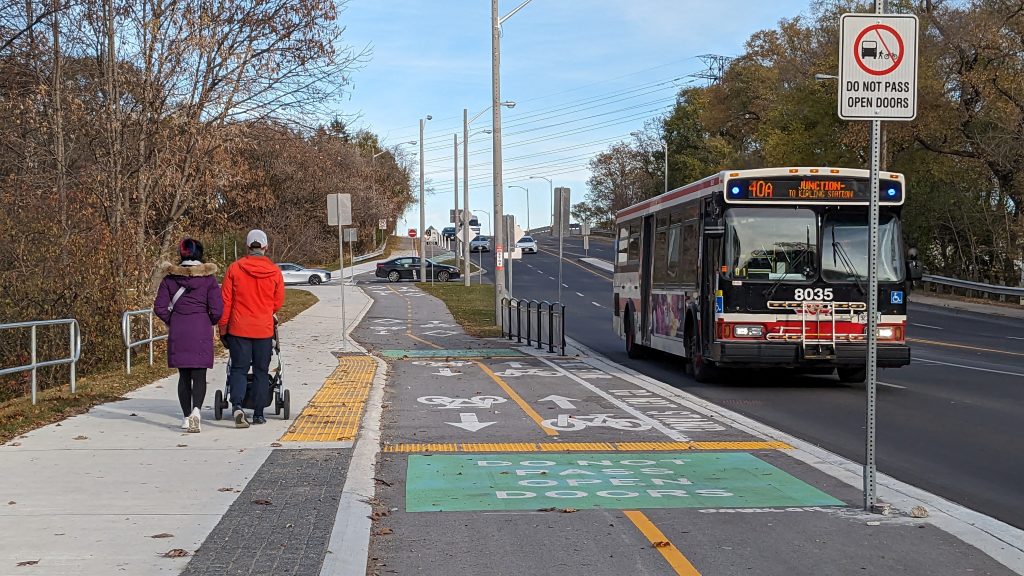 The City reconstructed The Kingsway from Lambeth Road to Dundas Street West in 2022. Road reconstruction involves removing and replacing both the asphalt surface of the road and the concrete road base, as well as curb and sidewalk, where they exist. Road reconstruction typically takes place every 75 to 100 years and presents an opportunity for the City to improve the design of a street with consideration to current policies and design guidelines, as well as future needs of the community.
The City reconstructed The Kingsway from Lambeth Road to Dundas Street West in 2022. Road reconstruction involves removing and replacing both the asphalt surface of the road and the concrete road base, as well as curb and sidewalk, where they exist. Road reconstruction typically takes place every 75 to 100 years and presents an opportunity for the City to improve the design of a street with consideration to current policies and design guidelines, as well as future needs of the community.
Missing sidewalks were installed on the west side of The Kingsway, from Dundas Street West to Lambeth Road, and on Wimbleton Road between Dundas Street West and the Humbertown Park driveway. The intersection of The Kingsway and Dundas Street West was reconstructed with a new design that includes dedicated cycling infrastructure and a safer pedestrian crossing area. Intersection improvements were installed at The Kingsway and Anglesey.
Pre-construction Notice (Dated: October 15, 2021)
Construction Notice (Dated: February 10, 2022)
Updated Construction Notice (Dated: October 6, 2022)
Improvements in this area consisted of:
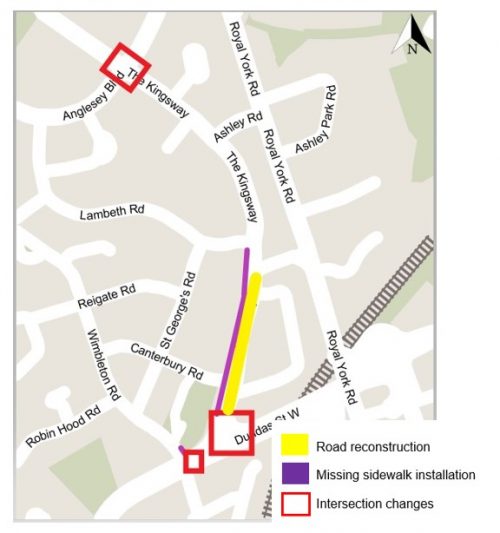
While we aim to provide fully accessible content, there is no text alternative available for some of the content on this site. If you require alternate formats or need assistance understanding our maps, drawings, or any other content, please contact us at cycling@toronto.ca.
The Kingsway is a Collector road with one travel lane in each direction and a speed limit of 40 km/hr. Daily traffic volume is approximately 4,500 vehicles. The street has no on-street parking, no bikeways and a boulevard sidewalk on the east side only. The intersection of The Kingsway and Dundas Street West previously featured channelized lanes that allowed for northbound right turns onto The Kingsway and westbound right turns onto Dundas Street West, separated by a large traffic island.
The section of The Kingsway from Dundas Street West to Lambeth Road was initially identified for resurfacing as part of the City’s Capital Works program. Further investigation into the condition of the road structure identified the need for more extensive reconstruction.
The City’s Missing Sidewalk Installation Policy specifies that sidewalks were to be installed on both sides of a street classified as ‘Collector’ during road reconstruction. This Council-approved policy is consistent with other City policies that support walking, pedestrian safety and the construction of sidewalks where they are missing.
A new sidewalk with curb and gutter was installed on the west side of The Kingsway, from Dundas Street West to Lambeth Road. This design, in which a combined sidewalk and curb is located immediately adjacent to the roadway, was selected because it had less impact on mature City trees and private landscaping than a boulevard sidewalk. Property owners on the west side of The Kingsway were notified directly about the planned sidewalk and potential impacts in the right-of-way.
The redesign of the intersection of The Kingsway and Dundas Street West was carried out to meet the objectives of the City’s Vision Zero Road Safety Plan to improve safety for of all road users, particularly people walking and cycling, and reduce traffic-related injuries and fatalities. The previous dedicated right turn channels at this intersection created poor sightlines and presented significant barriers to persons with disabilities. The City of Toronto’s policy is to remove right turn channels where possible and not to build new ones.
The new intersection design includes:
The bikeways facilitate a safe connection for people cycling between the existing bike lanes on Royal York Road and potential future cycling infrastructure on Dundas Street West, identified in the City’s Cycling Network Plan.
The new intersection design:
The intersection remains unsignalized and the existing restriction on southbound left turns and eastbound left turns were maintained.
The TTC relocated the existing bus stop on the north side of Dundas Street West closer to the intersection with Wimbleton Road.
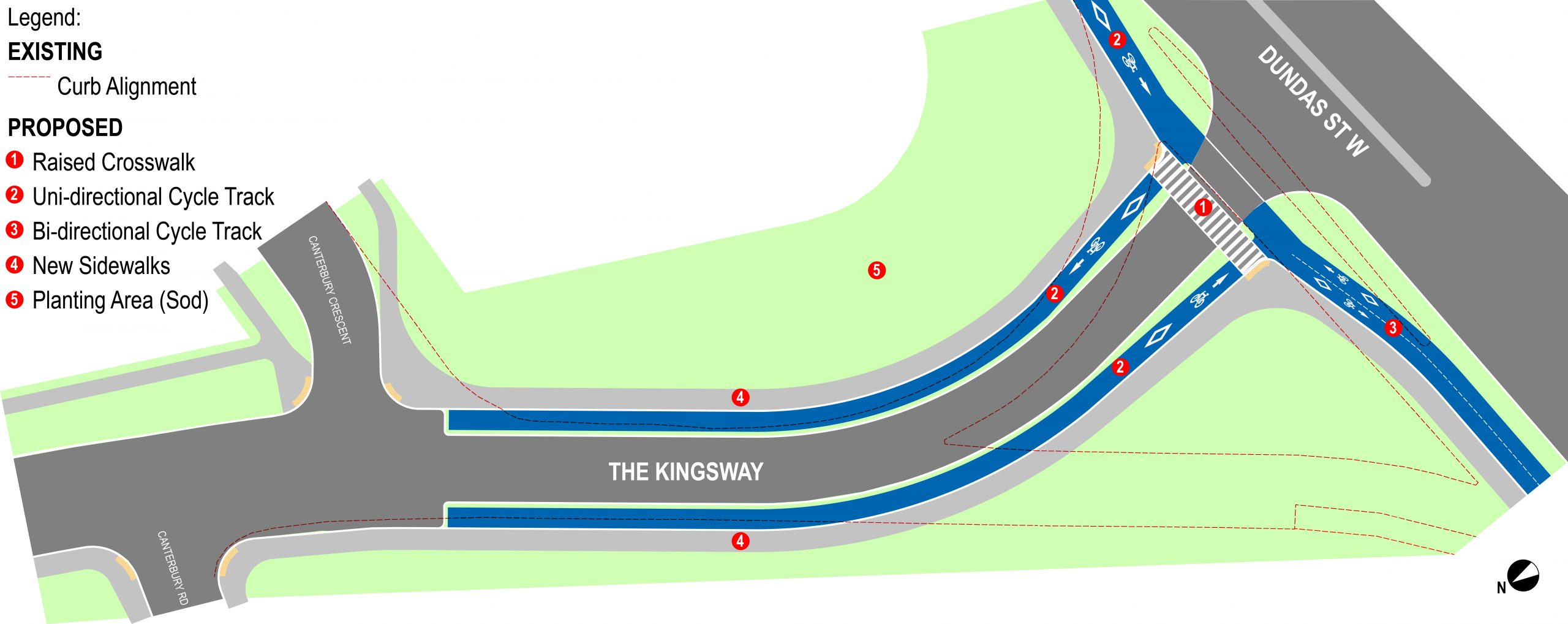
The redesign of the intersection of The Kingsway and Anglesey Boulevard was carried out to meet the objectives of the City’s Vision Zero Road Safety Plan to improve safety for all road users, particularly people walking and cycling, and reduce traffic-related injuries and fatalities.
The new intersection design includes:
The City installed Green Infrastructure at the northeast corner of The Kingsway and Anglesey Boulevard. This Green Infrastructure feature is designed with curb inlets and a depressed planting bed in a curb extension that provides temporary stormwater storage, filtration, and infiltration. These systems receive roadway runoff through curb inlets and are typically installed at intersections, mid-block areas, and at transit stops because they also provide traffic calming and aesthetic benefits.
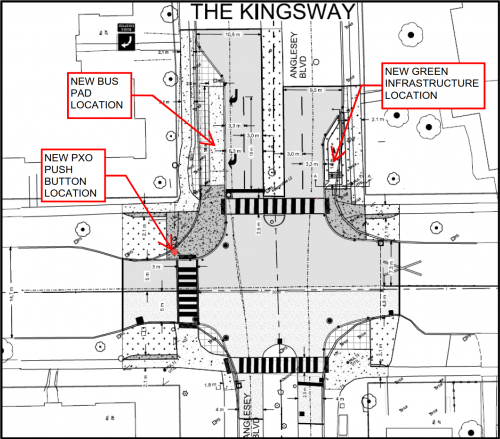
A new sidewalk was installed on the east side of Wimbleton Road, from Dundas Street West to the Humbertown Park driveway (located approximately 50 m north of Dundas) to create a safe and continuous sidewalk connection to the park. The existing parking area was converted to parallel parking to accommodate the sidewalk.
Intersection improvements at Dundas Street West and Wimbleton Road were made in conjunction with the new sidewalk installation.
The intersection changes include:
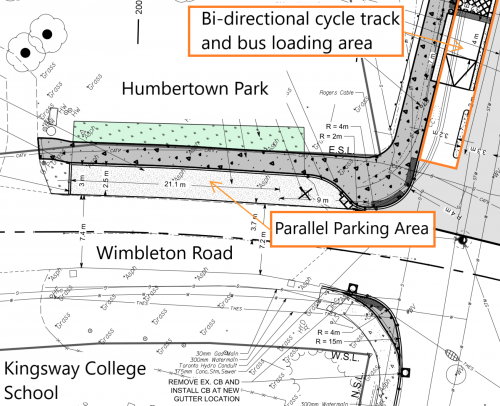
The City of Toronto has a set process for considering traffic calming measures, such as speed humps. This process is carried out separately from road reconstruction and involves consideration of a number of factors, including road classification, measured traffic volumes and speeds, and support from local residents.
Currently street parking is not permitted on The Kingsway between Dundas Street West and Lambeth Road. There are no planned changes to existing parking regulations on The Kingsway. In order to accommodate the new sidewalk on Wimbleton Road north of Dundas, the parking area was converted to parallel parking with space for approximately three vehicles.
Installation of a traffic signal was not part of the scope of work for Wimbleton Road and Dundas Street West under this contract. The City is investigating the basis for a traffic signal at this location and traffic studies are anticipated to start this fall. Planned construction under this contract will not preclude the future installation of a traffic signal.
Typically, consultation with the public is not carried out as part of road reconstruction, intersection redesign or missing sidewalk projects where there are no changes to the number of lanes of traffic or impacts to private property. Where there are impacts to the City-owned right-of-way as a result of a project, adjacent property owners are notified in advance of construction to identify and minimize impacts to privately owned items, such as landscaping features.
Owners of properties on the west side of The Kingsway, where the new sidewalk will require changes to the right-of-way, received early notification about the City’s plans to install a missing sidewalk. Kingsway College School’s administration was also contacted as part of the early notification. The initial project scope was extended to include a sidewalk on the east side of Wimbleton Road between Dundas Street West and the Humbertown Park driveway in response to their feedback. Wherever possible, the City works directly with affected property owners to make adjustments to sidewalk design in order to minimize impacts.